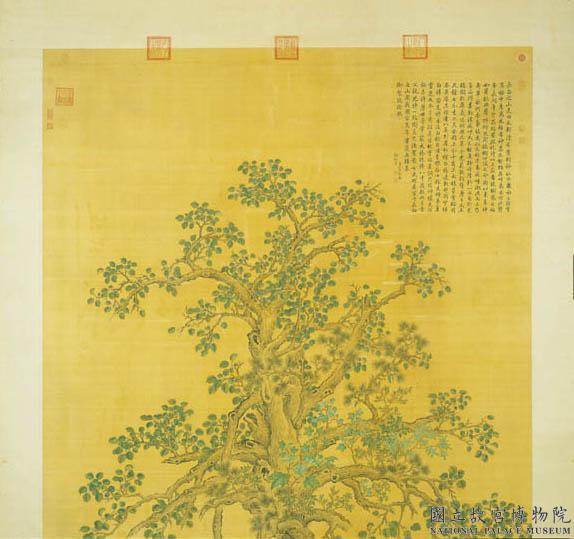清王幼學畫瑞樹圖 軸
推薦分享
資源連結
連結到原始資料 (您即將開啟新視窗離開本站)後設資料
- 資料識別:
- 故畫003682N000000000
- 資料類型:
- 類型:繪畫
- 型式:靜態圖像
- 著作者:
- 王幼學
- 主題與關鍵字:
- 靈芝 溪澗、湍泉
- 出版者:
- 數位化執行單位:國立故宮博物院
- 日期:
- 清高宗乾隆十五年(1750)
- 格式:
- 本幅 339.1x197.8公分、全幅 236.5公分
- 關聯:
- 石渠寶笈續編(御書房),第四冊,頁2244&*故宮書畫錄(卷八),第四冊,頁125&*故宮書畫圖錄,第十三冊,頁297-298&* 長白山有瑞樹ㄧ株,樹高十餘丈,上分十二大枝,莖葉各異,有松檜、白楊等八種,樹幹上還長了靈芝,十分奇特,乾隆帝曾作「長白瑞樹歌」,說這是國家萬年,道統無疆的象徵,並命王幼學畫此圖進覽。 王幼學(十八世紀)於一七二七年入宮為畫院畫家,曾經隨朗世寧學習油畫,擅長工筆花鳥畫,院藏另有一件一七四四年他與唐岱等合作的「院本新豐圖」 &*Auspicious Tree Wang Yu-hsűeh(18th c.) Ch’iug Dynasty A tall and unusual tree once grew at Mt. Longevity (Ch,ang-pai). It bore twelve branches with leaves of eight different kinds of trees, such as evergreen and poplar. Spirit fungus also grew on the trunk. The Ch’ien-lung Emperor (r. 1736-1795) once wrote “Song on Auspicious Tree at Ch’ang-pai”, in which he praised it as a symbol of dynastic longevity and the infinite synthesis of China’s orthodox traditions. He ordered Wang Yu-hsűeh to do a painting of the tree. Wang entered the court as an artist in 1727 and learned oil painting from the Jesuit Giuseppe Castiglione (Lang Shih-ning). Wang specialized in fine-line bird-and-flower painting. The Museum also has New City of Feng, in which he collaborated with T’ang Tai and other court artists.
- 管理權:
- 國立故宮博物院
授權聯絡窗口
- 國立故宮博物院圖像授權、出版授權、影音資料授權-申請流程說明
http://www.npm.gov.tw/zh-TW/Article.aspx?sNo=03003061






